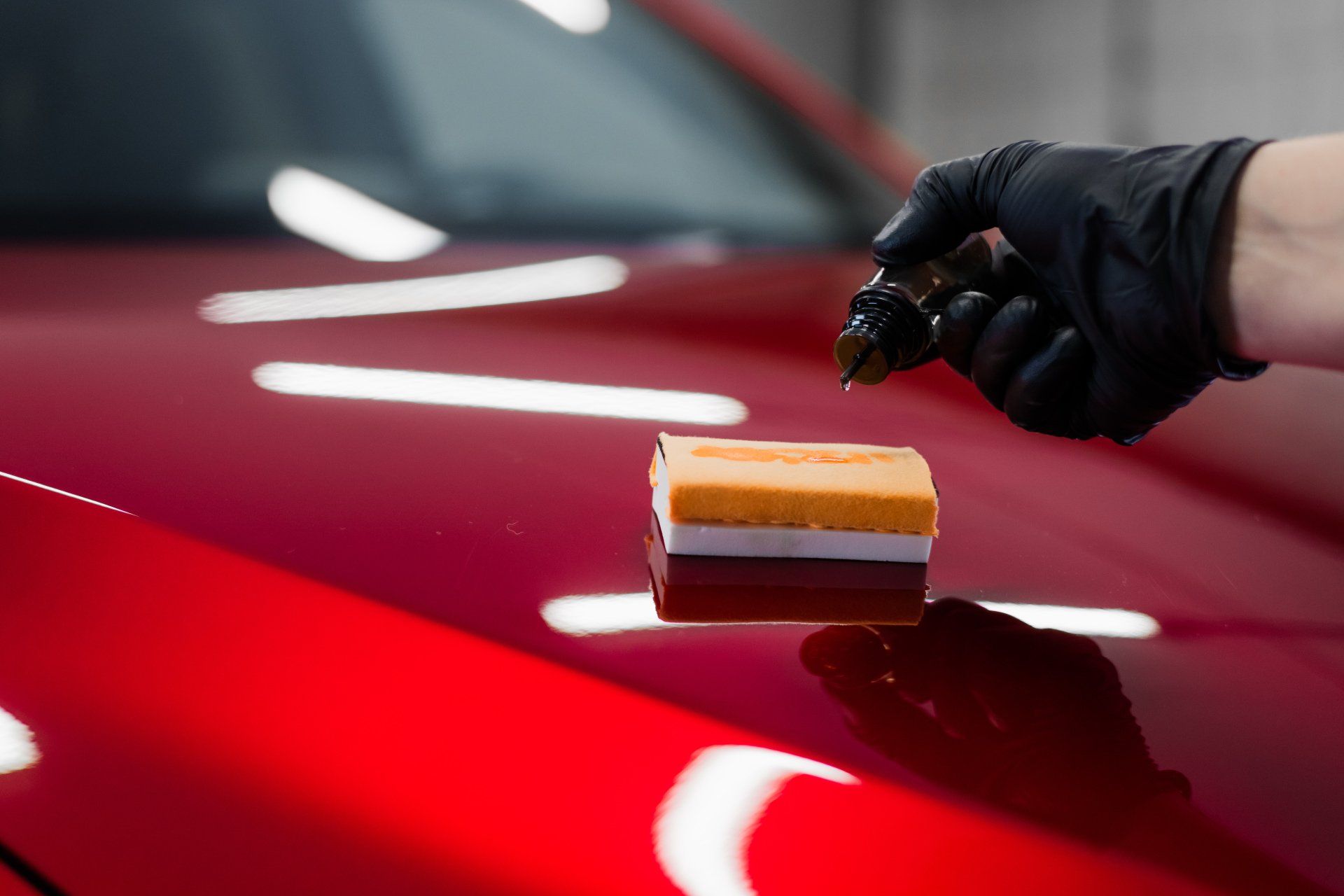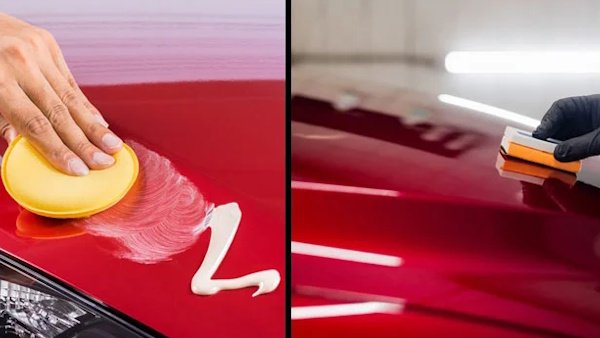Discovering the Scientific Research Behind Car Ceramic Coating and Its Protective Features
The science of car ceramic coating provides a remarkable study in sophisticated vehicle defense. Made up primarily of silicon dioxide and polymers, these finishings create a durable bond with vehicle paint. This interaction enhances longevity against environmental threats while providing hydrophobic benefits. The ins and outs of exactly how these layers work and their long-term advantages continue to be much less understood. Ceramic Coating Newark. Unloading these details reveals why ceramic coatings are becoming a preferred choice for lorry treatment
What Is Ceramic Coating?
Ceramic coating is a fluid polymer that chemically bonds to the surface of a vehicle's paint. This sophisticated safety layer improves resilience and supplies premium resistance to ecological aspects. Unlike conventional wax or sealers, which offer temporary defense, ceramic coatings produce a lasting shield that can withstand severe problems such as UV rays, acidic pollutants, and extreme weather condition. When applied correctly, the coating creates a hydrophobic surface, creating water to grain and slide off, which aids in preserving the automobile's cleanliness. Additionally, it offers enhanced gloss and deepness to the paint, making the vehicle show up more refined and dynamic. The application procedure typically entails comprehensive surface area prep work, consisting of cleaning and sprucing up, to ensure peak bonding. Consequently, ceramic finishes are ending up being significantly popular amongst car enthusiasts and those looking for to protect their investments, guaranteeing to keep the automobile's aesthetic allure while lowering the regularity of upkeep.
The Make-up of Ceramic Coatings
The complex formulation of ceramic finishings mostly includes silicon dioxide (SiO2), which is originated from all-natural sources like quartz and sand. This vital part provides the structure for the coating's longevity and safety high qualities. In addition to SiO2, ceramic finishes commonly consist of numerous polymers and additives that boost attachment, adaptability, and resistance to ecological variables. These compounds function synergistically to create a robust obstacle versus pollutants such as dirt, chemicals, and UV rays.Furthermore, some solutions incorporate titanium dioxide (TiO2) or other nanomaterials, which can increase the coating's hydrophobic buildings, leading to enhanced water repellency. The specific structure can vary significantly amongst manufacturers, influencing performance and long life. Eventually, the combination of these aspects culminates in a safety layer that not just improves the aesthetic appeal of lorries however likewise serves to prolong their life-span by protecting the surface area from potential damages.
Exactly How Ceramic Coatings Job
Comprehending just how ceramic coatings work includes discovering their chemical structure, which adds to their safety top qualities. The application procedure is vital for attaining ideal outcomes, while longevity and sturdiness elements figure out the coating's efficiency over time. Together, these elements highlight the advantages and performance of ceramic finishings for automobile defense.
Chemical Make-up Explained
While numerous car owners seek lasting security for their cars, the chemical composition of ceramic coverings plays an essential function in their efficiency. These finishes mostly contain silicon dioxide (SiO2), which is originated from natural minerals. This compound creates a strong bond with the car's paint, creating a sturdy, protective layer. Additionally, many ceramic coverings consist of titanium dioxide (TiO2), boosting their hydrophobic homes and resistance to UV rays. The visibility of polysiloxanes can better improve flexibility and resilience. Together, these aspects add to the coating's capability to fend off water, dust, and impurities, while additionally providing a high-gloss coating. Understanding this chemical structure helps car owners value the robust defense supplied by ceramic finishings.
Application Refine Summary
Applying ceramic coverings entails a thorough procedure that guarantees suitable bonding and security for the car's surface. Initially, complete cleaning and purification of the car's exterior are carried out to remove dust, gunk, and previous waxes. This action verifies that the surface area is without contaminations that can hinder adhesion. Following this, the paint is typically polished to boost quality and remove any type of imperfections. As soon as prepared, the ceramic coating is applied in small areas using an applicator pad, enabling consistent insurance coverage. The coating is after that left to cure, forming a strong chemical bond with the surface. Correct healing times and conditions are crucial, as they verify the coating attains its maximum effectiveness and safety top qualities.
Longevity and Sturdiness Aspects
Ceramic coatings are designed to give lasting protection with their sophisticated chemical composition, which produces a robust obstacle versus environmental pollutants. The longevity of these finishes is affected by variables such as the thickness of the application, the quality of the product, and the conditions under which the automobile is exposed. Top notch ceramic layers can last numerous years, withstanding scrapes, UV article rays, and chemical spots. Appropriate upkeep, including routine washing and regular reapplication, can additionally boost long life. Additionally, ecological variables like climate and exposure to toxins can influence the life expectancy of the coating. Generally, when used and maintained correctly, ceramic layers use extraordinary longevity, making them a prominent choice for car fanatics looking for to protect their lorry's appearance.
Hydrophobic Properties and Water Repellency
Hydrophobic residential properties are a characteristic of high quality car ceramic coverings, considerably enhancing the automobile's surface area performance. These coatings create a molecular bond with the car's paint, leading to a surface that fends off water efficiently. When water comes right into contact with a ceramic-coated surface area, it beads up and rolls off, decreasing the amount of fluid that continues to be on the paint. This habits not just adds to a visually pleasing look yet also reduces the buildup of pollutants such as dust, gunk, and roadway salts.The improved water repellency brings about less complicated cleaning and upkeep, as much less initiative is needed to remove unwanted substances. Furthermore, the hydrophobic nature of ceramic finishings helps in protecting against water places, which can mar the finish of uncoated surfaces. Generally, the consolidation of hydrophobic residential properties in ceramic finishings plays an essential role in maintaining the lorry's pristine appearance while streamlining maintenance.
Defense Versus Scratches and UV Damage
Car ceramic coverings offer significant security against scratches and UV damage. The scratch resistance system creates a durable layer that absorbs impacts, while the UV securing advantages aid preserve the car's paint integrity gradually. Together, these attributes contribute to a longer-lasting and visually attractive surface.
Scratch Resistance Device
Using sophisticated innovation, ceramic finishes provide a robust guard against scrapes and UV damages, enhancing the durability and appearance of automobile surfaces. The scratch resistance system of these coatings is attributed to their special molecular framework, which forms a durable bond with the vehicle's paint. This bond develops a hard, protective layer that can take in impacts and withstand abrasions. Furthermore, the smooth surface area of the coating lowers rubbing, making it challenging for pollutants to stick and trigger scrapes. The chemical composition of ceramic finishings commonly consists of nanoparticles that enhance the protective layer, further boosting its strength. Automobiles treated with ceramic finishings display substantially boosted scratch resistance compared to conventional wax or sealers, making certain an immaculate finish over time.
UV Shielding Benefits
The protective top qualities of ceramic finishes prolong past scratch resistance to click site include significant UV securing advantages. These coverings produce a robust barrier that mirrors unsafe ultraviolet rays, safeguarding the lorry's paint and underlying products. Extended exposure to UV radiation can cause fading, oxidation, and deterioration of the paint surface. By incorporating ceramic coverings, vehicle proprietors can efficiently mitigate these threats, preserving the visual allure and stability of their cars. In addition, the UV obstructing properties add to enhanced longevity, decreasing the frequency of repainting and maintenance. Inevitably, the combination of ceramic coatings uses a complete service for safeguarding lorries from the destructive results of sun direct exposure, making sure a sustained, vibrant appearance in time.
The Longevity and Upkeep of Ceramic Coatings

Often Asked Concerns
Can Ceramic Coating Be Applied to Any Kind Of Kind Of Vehicle?
Ceramic coating can be used to numerous kinds of lorries, including vehicles, trucks, and motorbikes. However, surface area preparation and compatibility with particular materials are essential for excellent bond and effectiveness of the coating.
Just How Much Does Ceramic Coating Usually Cost?
Ceramic coating commonly costs between $500 and $2,000, depending upon variables such as automobile size, coating high quality, and specialist application. The financial investment can give durable protection and boost the lorry's appearance with time.

Is Professional Application Required for Finest Outcomes?
The requirement of specialist application often depends on desired outcomes. Experts normally guarantee correct surface area preparation and application strategies, bring about optimal bonding and longevity of the coating, which might be challenging for unskilled individuals to attain.
Can Ceramic Coatings Be Eliminated or Fixed?
Ceramic finishes can be removed or repaired, though the process might call for particular solvents or strategies - Ceramic Coating Newark. Correct removal is vital to stay clear of damages to the underlying surface, highlighting the importance of specialist help for optimal results
How Does Porcelain Coating Compare to Typical Wax?
The contrast between ceramic coating and conventional wax discloses that ceramic coverings provide superior resilience, improved security versus environmental impurities, and longer-lasting sparkle, while wax needs extra regular application and supplies much less total resistance to damage.